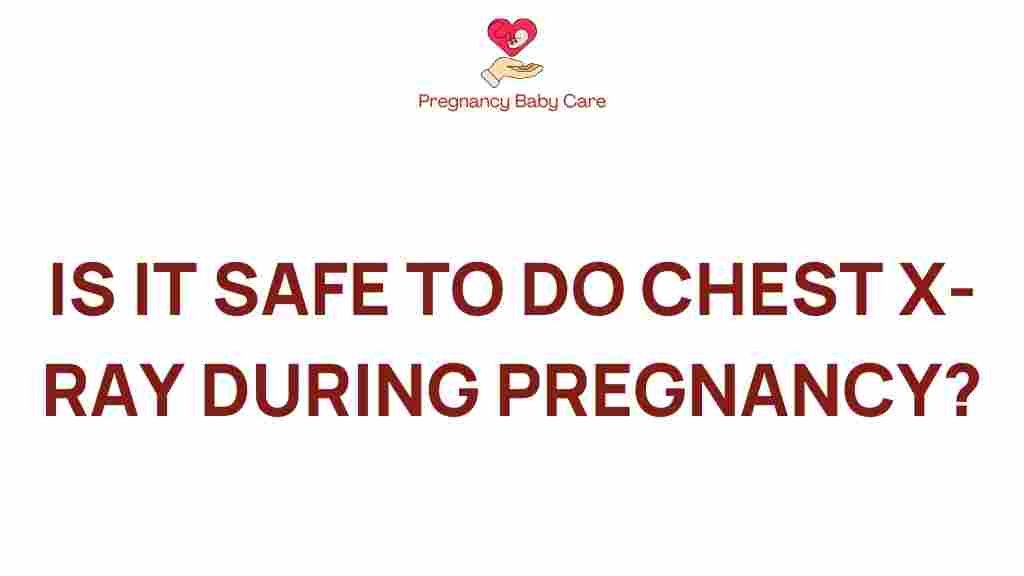The Hidden Risks: Is a Chest X-Ray Safe During Pregnancy?
When it comes to maternal health, ensuring the safety of both mother and fetus is paramount. One common concern that arises during pregnancy is the necessity of medical imaging, particularly chest X-rays. With increasing awareness about pregnancy safety, many expectant mothers wonder: Is a chest X-ray safe during pregnancy? This article delves into the risks associated with chest X-rays, the impact of radiation exposure on fetal development, and the considerations that should guide healthcare decisions during this critical time.
Understanding Chest X-Rays and Radiation Risks
Chest X-rays are a widely used diagnostic procedure that allows healthcare professionals to view the lungs, heart, and chest wall. While they are essential for diagnosing various conditions, they also involve exposure to radiation, which can raise concerns during pregnancy.
What is a Chest X-Ray?
A chest X-ray is a non-invasive imaging test that produces images of the structures within the chest. It is commonly used to:
- Diagnose pneumonia
- Identify heart conditions
- Detect tumors
- Evaluate injuries
Radiation Exposure During Pregnancy
Radiation exposure is measured in millisieverts (mSv). A typical chest X-ray exposes a patient to approximately 0.1 mSv of radiation. For comparison, the average person is exposed to about 3 mSv of background radiation annually. Understanding the relationship between radiation exposure and pregnancy safety is crucial.
How Radiation Affects Fetal Development
The primary concern regarding chest X-rays during pregnancy is the potential impact on fetal development. Various studies have examined the effects of radiation exposure on a developing fetus, leading to the following insights:
- First Trimester Sensitivity: The first trimester is the most critical period for fetal development. High doses of radiation (above 10 mSv) during this time can increase the risk of congenital abnormalities.
- Second and Third Trimester Considerations: While the risks are lower in the later stages of pregnancy, caution is still advised. Minimal exposure, such as that from a chest X-ray, is generally considered safe.
- Long-term Effects: Some studies suggest that high levels of radiation exposure might be linked to an increased risk of childhood cancers, but the risk from a single chest X-ray is very low.
Making Informed Healthcare Decisions
When faced with the decision to undergo a chest X-ray during pregnancy, several factors should be considered to ensure optimal maternal and fetal health.
Consulting Healthcare Professionals
Before proceeding with any diagnostic procedures, it’s essential for pregnant women to have thorough discussions with their healthcare providers. Questions to ask include:
- Is the chest X-ray absolutely necessary?
- Are there alternative imaging methods that do not involve radiation?
- What are the risks versus benefits of conducting the X-ray at this time?
Alternatives to Chest X-Rays
In some cases, healthcare providers may recommend alternatives to chest X-rays, especially during the early stages of pregnancy. These alternatives could include:
- Ultrasound: This imaging technique uses sound waves and does not involve radiation, making it a safer option during pregnancy.
- Magnetic Resonance Imaging (MRI): MRI is another radiation-free imaging method that can provide detailed images of soft tissues and organs.
Step-by-Step Process for Pregnant Women Needing a Chest X-Ray
If a chest X-ray is deemed necessary, here’s a step-by-step process to follow to ensure safety:
- Consult Your Doctor: Discuss your symptoms and the need for imaging.
- Weigh Risks and Benefits: Understand the reasons for the X-ray and how it will impact your treatment.
- Inform the Radiology Staff: Always tell the radiologist or technician that you are pregnant.
- Use Protective Measures: Lead aprons can be used to shield the abdomen and fetus from radiation exposure during the procedure.
- Follow-Up: After the X-ray, discuss the results with your healthcare provider and any further steps needed.
Troubleshooting Tips for Expectant Mothers
As an expectant mother, it is natural to have concerns about safety during medical procedures. Here are some troubleshooting tips for those considering a chest X-ray:
- Keep Open Communication: Ensure you communicate all your concerns with your healthcare provider.
- Ask About Timing: If possible, schedule the chest X-ray for a time when it may pose the least risk, such as the second trimester.
- Request Additional Safety Measures: Inquire about the use of lead shielding and other safety protocols during the procedure.
Conclusion: Prioritizing Maternal and Fetal Health
In summary, while chest X-rays are a valuable diagnostic tool, their use during pregnancy warrants careful consideration. Understanding the radiation risks associated with chest X-rays and the potential impact on fetal health is crucial for making informed healthcare decisions. By consulting with healthcare professionals, exploring alternative imaging options, and following safety protocols, expectant mothers can prioritize their health and the health of their unborn child.
If you have further questions about pregnancy safety and medical imaging, consider visiting reputable health resources like the American College of Obstetricians and Gynecologists for more information. Additionally, for personal stories and experiences, you can check out articles on various health blogs here.
Always remember, your health and safety are of utmost importance. When in doubt, seek guidance from your healthcare provider.
This article is in the category Health and created by PregnancyBabyCare Team
